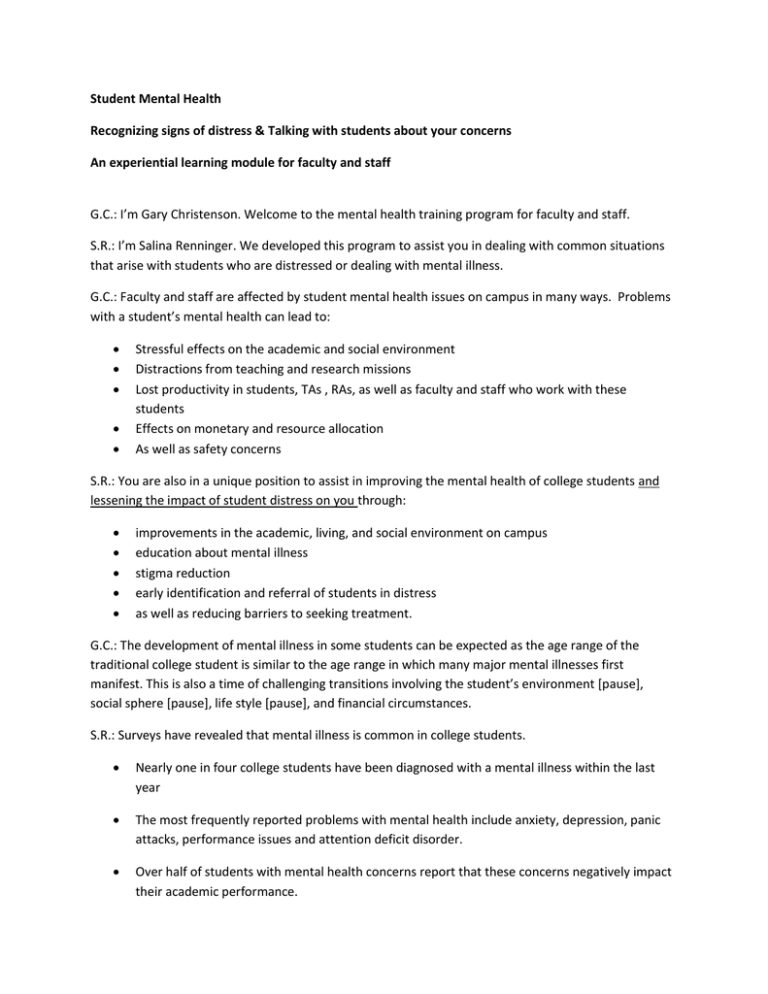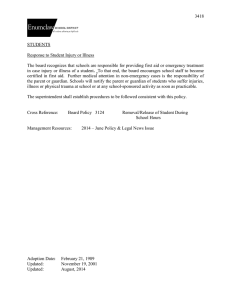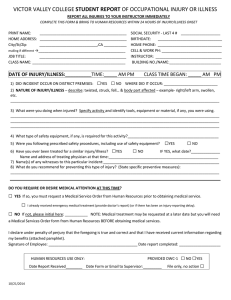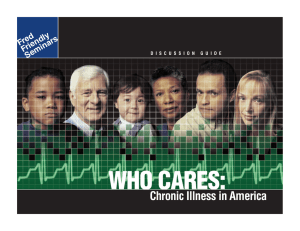Student Mental Health An experiential learning module for faculty and staff
advertisement

Student Mental Health Recognizing signs of distress & Talking with students about your concerns An experiential learning module for faculty and staff G.C.: I’m Gary Christenson. Welcome to the mental health training program for faculty and staff. S.R.: I’m Salina Renninger. We developed this program to assist you in dealing with common situations that arise with students who are distressed or dealing with mental illness. G.C.: Faculty and staff are affected by student mental health issues on campus in many ways. Problems with a student’s mental health can lead to: Stressful effects on the academic and social environment Distractions from teaching and research missions Lost productivity in students, TAs , RAs, as well as faculty and staff who work with these students Effects on monetary and resource allocation As well as safety concerns S.R.: You are also in a unique position to assist in improving the mental health of college students and lessening the impact of student distress on you through: improvements in the academic, living, and social environment on campus education about mental illness stigma reduction early identification and referral of students in distress as well as reducing barriers to seeking treatment. G.C.: The development of mental illness in some students can be expected as the age range of the traditional college student is similar to the age range in which many major mental illnesses first manifest. This is also a time of challenging transitions involving the student’s environment [pause], social sphere [pause], life style [pause], and financial circumstances. S.R.: Surveys have revealed that mental illness is common in college students. Nearly one in four college students have been diagnosed with a mental illness within the last year The most frequently reported problems with mental health include anxiety, depression, panic attacks, performance issues and attention deficit disorder. Over half of students with mental health concerns report that these concerns negatively impact their academic performance. Of further concern, one in ten of all students report having seriously considered suicide and 1% of students report having actually attempted suicide within the last 12 months. Stress may play a significant role in mental illness. Twenty-nine percent of students report being unable to manage their stress level. Stress is not just academic but can include other significant life events. S. R.: Despite the presence of mental health problems in college students many of them go untreated. G. C.: Lack of treatment is probably attributable in part to students’ lack of knowledge about where to obtain services. You can help improve this situation through identification and referral of students in need of mental health services. S.R.: This highly interactive training program provides realistic practice for helping your students manage the most common stressors and mental health problems they face. The skills you learn here could help a homesick student find his way, prevent a depressed student from failing, or even save a life. Statistics cited in this video were obtained from the following sources: · Center for Disease Control 1997, Youth Risk Behavior Surveillance · 2007 College Student Survey done at the University of Minnesota Twin Cities • UMTC 2007 Enrollment 43,737 • Surveyed 6,000 • Completed Surveys 2,920 • Response Rate 48.7%



